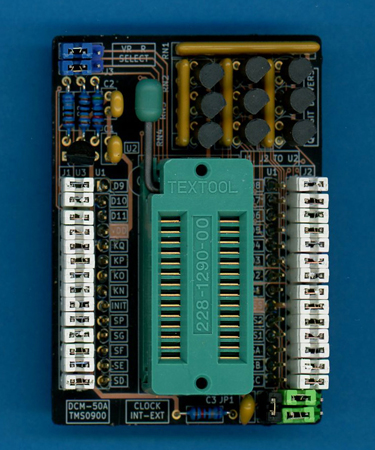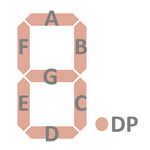
DATAMATH CALCULATOR MUSEUM
 |
DATAMATH CALCULATOR MUSEUM |
Datamath Calculator Museum DCM-50A TMS0900 Adapter
| Date of introduction: | September 21, 2022 | Display technology: | n.a. |
| New price: | Display size: | n.a. | |
| Size: | 2.6" x 1.9" x 1.00" 66 x 48 x 25 mm3 |
||
| Weight: | 1.2 ounces, 32 grams | Serial No: | 0001 |
| Batteries: | n.a. | Date of manufacture: | mth 03 year 2023 |
| AC-Adapter: | n.a. | Origin of manufacture: | USA |
| Precision: | Integrated circuits: | ZIF-Socket for
TMS0950 and TMS0970 (SPDIP) |
|
| Memories: | |||
| Program steps: | Courtesy of: | Joerg Woerner |

![]() The
TMS0950 Product Family is based on the
TMS1000 "computer-on-a-chip"
introduced already in 1974 with the SR-16
"Slide Rule" calculator and integrated the first time both segment drivers
and digit drivers on the silicon chip enabling low-cost, four function
calculators like the TI-1200. To accommodate the necessary external
components used for the integrated drivers while maintaining its cost-optimized
28-pin package, Texas Instruments removed 2 of the 11 R Outputs of the TMS1000.
The
TMS0950 Product Family is based on the
TMS1000 "computer-on-a-chip"
introduced already in 1974 with the SR-16
"Slide Rule" calculator and integrated the first time both segment drivers
and digit drivers on the silicon chip enabling low-cost, four function
calculators like the TI-1200. To accommodate the necessary external
components used for the integrated drivers while maintaining its cost-optimized
28-pin package, Texas Instruments removed 2 of the 11 R Outputs of the TMS1000.
Starting already before the famous TMS1802, known as "calculator-on-a-chip", all Texas Instruments designs used Digit-Scanning to control both the display and keyboard of the calculators. In Digit-Scanning the typically 9 or 11 digit outputs are activated briefly in a round-robin approach and the corresponding segment patterns for the numerals, minus sign, decimal point and various conditions like overflow or calculating error are output briefly on the 8 segment pins while the keyboard matrix is read in (scanned).
 From
the perspective of a single digit driver this technique translates into a
load between one segment for the minus sign and eight segments for the
numeral "8" with the decimal point activated per digit time. Not an easy design
task with PMOS transistors for LED displays in common cathode (CC) configuration
and Texas Instruments introduced with the TMS0950 the so-called Segment-Scanning. In
Segment-Scanning the 8 segment outputs A to G and DP are activated briefly one
after the other together with
the corresponding digit outputs and the keyboard matrix is read in. The
highest currents are now on the segment drivers instead on the digit drivers, a
better match with the PMOS processes used with early calculator chips.
From
the perspective of a single digit driver this technique translates into a
load between one segment for the minus sign and eight segments for the
numeral "8" with the decimal point activated per digit time. Not an easy design
task with PMOS transistors for LED displays in common cathode (CC) configuration
and Texas Instruments introduced with the TMS0950 the so-called Segment-Scanning. In
Segment-Scanning the 8 segment outputs A to G and DP are activated briefly one
after the other together with
the corresponding digit outputs and the keyboard matrix is read in. The
highest currents are now on the segment drivers instead on the digit drivers, a
better match with the PMOS processes used with early calculator chips.
The Datamath Calculator Museum
DCM-50A
Platform was designed for single-chip calculator circuits using external
digit drivers and we consequently developed with this TMS0900 Adapter a solution
to "undo" the integrated digit drivers of the TMS0950 chips. One side effect
using the TMS0900 Adapter is
unfortunately a rather inhomogeneous brightness of the LED display with large
numbers. The DCM-50A Platform controls the segment currents per digit, with
Segment-Scanning the available current per segment needs to be shared between 1
digit or up to 9 digits. As a result are some digits rather bright and some
digit somewhat dim when displaying larger numbers.
To access all features of an electronic calculator based on the TMS0950 Product Family, the schematics and layout of the TMS0950 Adapter are providing accordingly:
| • Local voltage regulator to generate VDD
(-9V) of TMS0950 • Nine level-translators from the TMS0950 low-side switching digit drivers to DMC-50A compatible high-side switching digit drivers • Voltage divider for the VR pin of the TMS0950 • 6.8k Ohm Resistor for the R pin of the TMS0950 • 68k Ohm Resistor and optional 68pF Capacitor for the integrated Clock Oscillator |
Texas Instruments introduced within 15 months the TMS0970 as direct and pin-compatible successor of the TMS0950, further reducing the manufacturing costs of electronic calculators with dropping the external 4 resistors and 1 capacitor from the printed circuit board (PCB). The next step in cost-optimization was the introduction of TMS0970/TMC0900 versions in a 28-pin Shrink Plastic Dual In-line Package, actually the package we use with the TMS0900 Adapter.

 Undisclosed
to us while we developed the TMS0900 Adapter was the fact that Texas Instruments
added with the TMS0970 the 2 missing R Outputs from the original TMS1000 design
back to the silicon. As of today - almost 50 years after its introduction - we
know with the TMS0973 located in Electra's
Bearcat 210 Computer Radio Scanner only one application unleashing the full
potential of the TMS0972 used with millions and millions of generic "FBWM"
(Four-Banger With Memory) calculators.
Undisclosed
to us while we developed the TMS0900 Adapter was the fact that Texas Instruments
added with the TMS0970 the 2 missing R Outputs from the original TMS1000 design
back to the silicon. As of today - almost 50 years after its introduction - we
know with the TMS0973 located in Electra's
Bearcat 210 Computer Radio Scanner only one application unleashing the full
potential of the TMS0972 used with millions and millions of generic "FBWM"
(Four-Banger With Memory) calculators.
Please notice that the TMS0900 Adapter needs to be plugged into the rightmost TMS1000 Pin-Headers on the DCM-50A Platform.
The layout of the TMS0900 Adapter maps the nine Digit Outputs D9 (MSD) to D1 (LSD) of the device under test to the corresponding R10 to R2 Outputs of the TMS1000 socket, hence creating an MSD-aligned 7-Segment Display on the DCM-50A Platform:
| DCM-50A LED Display Digit | 12 (MSD) |
11 |
10 |
9 |
8 |
7 |
6 |
5 |
4 |
3 |
2 |
1 (LSD) |
| TMS1000 Port (TI Mode) |
n.a. | R10 (sign) |
R9 (MSD) |
R8 |
R7 |
R6 |
R5 |
R4 |
R3 |
R2 |
R1 |
R0 (LSD) |
| TMS1000 Port (SR Mode) |
R10 (sign) |
R9 (MSD) |
R8 |
R7 |
R6 |
R5 |
R4 |
R3 |
R2 (LSD) |
R10 (sign) |
R1 (EXP) |
R0 (EXP) |
| TMS0950 Port | n.a. | D9 (sign) |
D8 (MSD) |
D7 |
D6 |
D5 |
D4 |
D3 |
D2 |
D1 (LSD) |
n.a. | n.a |
| TMS0970 Port (TMS0950 Mode) |
n.a. | D9 (sign) |
D8 (MSD) |
D7 |
D6 |
D5 |
D4 |
D3 |
D2 |
D1 (LSD) |
n.a. | n.a |
| TMS0970 Port (Native Mode) |
n.a. | R9 (MSD) |
R8 |
R7 |
R6 |
R5 |
R4 |
R3 |
R2 |
R1 (LSD) |
n.a. | n.a |
If you have additions to the above article please email: joerg@datamath.org.
© Joerg Woerner, September 5, 2023. No reprints without written permission.